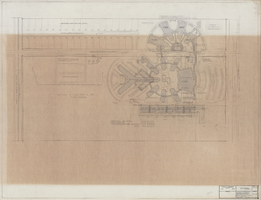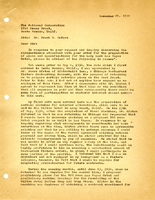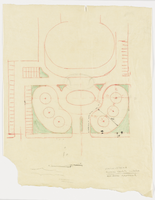Search the Special Collections and Archives Portal
Rissman, Homer A., 1927-2001
Description
Known for his unique contributions to the Las Vegas Strip, Homer Rissman and his brother Marshall, influenced the development of Las Vegas from the 1950’s to the late 1980’s through his work expanding or renovating hotels and country clubs on the Las Vegas Strip like the Hacienda, Tropicana, Dunes, Tally Ho, Castaways and the Silver Slipper. Homer Rissman was born on February 22, 1927 in Chicago, Illinois. The son of an architect, Maurice Rissman (d.1942),of the Chicago firm of Rissman and Hirschfeld, Homer attended the Illinois Institute of Technology in Chicago and earned a Bachelor’s of Architecture in 1947. He went into practice for himself in 1949. His firm worked on many small commercial projects and designed private and multi-family residences. These multi-family residences include now highly sought after examples of Mid-Century row houses and townhouses in the Lakeview neighborhood of Chicago.
In 1954, Rissman was invited by James Efston, of the Chicago restaurant fixture contracting company Efstonbuilt Co., to re-model the coffee shop and drugstore in the Wilton Hotel in Long Beach, California. Rissman settled in Santa Monica and, through Efston’s contacts in the restaurant business, began designing restaurants and motels in Southern California. In Southern California, Rissman learned, along with other architects like John Lautner, Wayne McAllister, and Martin Stern, to adapt and create new architectural forms for the needs of the growing interstate highway infrastructure and styled to an emerging lifestyle influenced by car culture and the space age.
Rissman’s association with Efston then brought Rissman his first project in Las Vegas¬. Rissman was asked by Efston to design a hotel that Efston was developing in Las Vegas, the Lady Luck. The Lady Luck eventually opened as the Hacienda Hotel and Casino in 1956. In 1960 Homer Rissman and his brother Marshall established the firm Rissman & Rissman. When Homer relocated to Las Vegas, Marshall stayed in Los Angeles. They divided the work with Homer doing much of the design work and Marshall overseeing the construction documents. While working on the Hacienda in Las Vegas, the Rissmans developed a long standing association with the Hacienda hotel chain and later designed hotels for their locations in Stockton, Bakersfield and Fresno, California. The Rissmans also developed a relationship with Holiday Inn and became their in-house architects, Marshall doing much of the design work creating prototypical “franchise” designs used throughout Southern California as well as on the Las Vegas strip. After Marshall Rissman's death in 1981, Homer Rissman continued the firm under the name Rissman & Rissman.
Once established in Las Vegas as an hotel architect, Homer Rissman found steady work expanding or renovating hotels and country clubs on the Las Vegas Strip. His work included additions to the Hacienda, Tropicana, Dunes, Tally Ho, Castaways and the Silver Slipper. His next major projects were the total redesign and re-building of the Frontier Hotel in 1966, and then the Bonanza in 1967. Both Rissman and Martin Stern developed plans and designs for Binion’s Horseshoe, the Thunderbird/Silverbird, and unrealized proposals for the Aladdin and Landmark Hotels. In 1968 Rissman created the original circus tent concept for the iconic Circus Circus Casino in association with Jay Sarno, who had recently opened Caesars Palace. Rissman, commenting in a newspaper interview, said ”People expect to see to see things here that they don’t see on the main street of their own communities, a Circus, Circus, transplanted anywhere else wouldn’t make much sense. The visual impact can’t be denied.”
His appreciation of outré on the Las Vegas Strip also found an outlet in the Holiday Casino where he design a replica of a riverboat attached to his center strip Holiday Inn Hotel for Claudine Williams and Harrah’s. Rissman continued designing renovations and expansions to existing hotels, including a second and third addition to Martin Stern’s original International Hotel, then operating as the Las Vegas Hilton. Both Rissman and Stern each had the opportunity to redesign each other’s work. Rissman’s riverboat design for the Holiday Casino was later demolished to make room for a hotel tower addition designed by Martin Stern when the property was acquired in full by Harrah’s [Entertainment].
In 1976 Rissman’s work with Hilton continued with the Flamingo Hilton Hotel and established his place on the contemporary Las Vegas Strip Skyline. In order to keep pace with growing scale of Las Vegas Strip hotel properties, Rissman, in six construction phases from 1976 to 1993, completed a series of towers for the Flamingo Hilton. Rissman’s design re-created the corner of Flamingo and the Strip, with a series of matching, pink glassed, white concrete towers. For this project, Homer Rissman created a set of drawings of the existing, mostly as originally constructed, Flamingo buildings from an on-site survey of the buildings. The tower’s design was then exported in 1990 by Rissman to the Flamingo Hilton (now Aquarius Casino Resort) in Laughlin, Nevada.
In 1989 Rissman created the plans for Sheldon Adelson’s new Sands Expo and Convention Center. Rissman was the most prominent architect of Primm, Nevada, where he designed Whiskey Pete’s, the Primadonna and Buffalo Bills. He also designed the Las Vegas luxury apartment complex, Regency Towers where he and his wife Alice resided. Homer Rissman died in Las Vegas in 2001 and his documents were donated to UNLV Special Collections by his wife in 2002. He received posthumously a Lifetime Achievement Award from the AIA Nevada chapter in 2001 and a Special Service Award from the same chapter in 2002.
Source:
"Dreaming the Skyline: Homer Rissman," University of Nevada, Las Vegas Digital Collections, accessed on April 09, 2017, http://digital.library.unlv.edu/skyline/architect/homer-rissman.
Relationships




